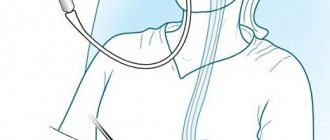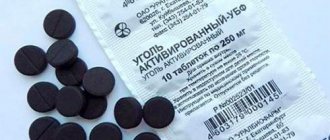If you are planning an appointment with a proctologist
, then you need to prepare the rectum accordingly, that is, clean it by giving a cleansing enema. If you have severe pain or quite heavy bleeding, then you do not need to give an enema before the initial medical examination. Do not injure the sore areas again. The doctor will conduct a minimal instrumental examination (anoscopy), and without this preparation it will be enough to have a “chair” before the examination. A cleansing enema is performed no later than 2 hours before examination by a proctologist, usually twice. Also, you should not eat foods that cause flatulence the day before. If you have an appointment in the evening, but there is no way to prepare during the day, then a cleansing enema can be given after the morning “stool”.
What is needed to perform an enema?
To perform a cleansing enema,
use an Esmarch mug (it can be bought at almost any pharmacy). This is a tank (glass, enamel or rubber) with a capacity of 1.5-2 liters. At the bottom of the mug there is a nipple onto which a thick-walled rubber tube is placed. The length of the tube is about 1.5 m, the diameter is 1 cm. The tube ends with a removable tip (glass, plastic) 8-10 cm long. The tip must be intact, with smooth edges. It is preferable to use plastic tips, since a glass tip with a chipped edge can seriously injure the intestine. Next to the tip on the tube there is a tap that regulates the flow of fluid into the intestines.
For enemas, use drinking water. The water temperature is about 37.7-38 degrees. For children, it is better to use only boiled water.
What are the dangers of using laxatives and enemas?
Class Clinic
Why do people use laxatives and enemas on a regular basis? For the purpose of losing weight and as a remedy for chronic constipation. But in some cases, experts assess these methods as controversial, and sometimes as detrimental to the health and normal functioning of the intestines. Natalya Dmitrievna Volodchenkova, a practicing proctologist at the Kaliningrad Medical Center Class Clinic, Candidate of Medical Sciences, talks about the harm that excessive use of enemas and laxatives can cause.
What, in your opinion, is the reason for the wave of “hobby” for laxatives and enemas, and why have these methods become so popular today?
One of the main categories of people who use enemas and laxatives are those who want to lose weight quickly. The second category, also due to an unbalanced diet, suffers from frequent constipation, and in turn also strives to get rid of them. I would like to emphasize that in both the first and second cases, the root of the problem is nutrition. The popularity of fast food naturally leads to the fact that people begin to gain weight and digestion is impaired.
What are the consequences of excessive use of laxatives and enemas?
You need to understand well that the body is an integral interconnected complex of systems, like a clockwork. If one system fails, it affects all the others. It's easy to explain with an example. One of the patients came to me with chronic constipation and stated that he did not follow the recommendations of the gastroenterologist, but used enemas and laxatives. I had to explain that the processes taking place “below” begin “from above”. We need to understand very clearly what we eat, for what purpose and how it will affect the digestive tract.
By regularly using enemas and laxatives, the patient actually turns off the intestines from the normal digestive process and constantly forces him to use “crutches” in the form of excessive procedures and drugs. Because of this, peristalsis worsens, since the body, with such “help,” does not see the point in moving the intestinal walls on its own. As a result, this leads to persistent intestinal atony, i.e. to weak peristalsis, which directly depends on the use of laxatives and enemas. This is directly related to the “memory” of muscle cells and the formation of a kind of conditioned reflex. As a result, the intestines practically lose the ability to empty themselves without the help of enemas and laxatives.
Can we call this a kind of addiction?
Absolutely true, but it is a physiologically determined dependence. In relation to laxatives, we can also talk about addiction, i.e. about the persistent need for them when the possibility of normal bowel movements is lost. Moreover, many patients themselves note the addictive effect and regard their “hobby” as an addiction.
If we talk about constipation, we can say with confidence: despite the symptomatic effect, the problem, in most cases, gets worse, and enemas and laxatives become a constant necessity.
Do people who try to lose weight this way become addicted?
In situations with weight loss, even if you do not take into account severe cases of psychogenic anorexia, you can trace the same signs of addiction. Without correction of eating behavior and lifestyle, a person begins to gain weight again and resorts to the well-known recipe of “laxatives + enemas,” bringing the intestines to a state of persistent atony, in which these drugs and procedures become permanent.
Do these remedies help you lose weight for a long time while normalizing your diet?
Only for a short time and without a guarantee. Those losing weight, as a rule, combine the diet with enemas and laxatives. As a result, as a reaction to a depleting diet and undermining digestion with laxatives, the body turns on compensatory mechanisms, one of which is a constant feeling of hunger. At the same time, digestive substances are constantly produced, which process food almost completely in order to get the maximum from it, which, even with small portions, does not allow weight loss.
The excess that comes from food is stored as fat, as the body uses it as a response to hunger. And such an organism regularly faces hunger and, accordingly, strives to store as much fat as possible. In addition, a person does not get full, but with this approach he sooner or later begins to eat, which actually leads to the fact that body weight becomes the same, and in some cases increases.
What other negative effects could there be from the constant use of enemas and laxatives?
A detrimental effect on microflora, not only harmful, but also beneficial, necessary for normal digestion. Beneficial microorganisms are mechanically washed out of the intestines, including the same bifidobacteria that we get from fermented milk products.
Moreover, when pathogenic bacteria, which are normally found in small quantities in our intestines, are destroyed, a serious blow is dealt to the immune system. This “sterilization” of the intestines leads to rapid fatigue and reduces performance.
In addition to the problems already described, hemorrhoids can often occur from such regular “treatment” and “recovery,” and if they already exist, the process moves to the next stage. Irritable bowel syndrome may occur, with a huge number of unpleasant manifestations - from discomfort and bloating to cramping pain, diarrhea and constipation. Regular use of enemas and laxatives is not effective in the long term against either constipation or excess weight. On the contrary, the use of these methods of “cleansing the body” on an ongoing basis is fraught with intestinal atony, addiction, decreased immunity, loss of strength, as well as weight gain and constipation.
Make an appointment with Natalya Dmitrievna Volodchenkova on the website or by phone.
Administration of an enema
Lie on the bed (couch) closer to the edge on your left side with your legs bent and pulled towards your stomach.
Place an oilcloth (plastic film) under your buttocks, and lower the free edge of it into a bucket in case you cannot hold water. Pour 1-1.5 liters of water at room temperature into Esmarch's mug, lift it up to a height of 1-1.5 m and lower the tip down to release a small amount of water and along with it air from the tube. Fill the tube (drain some liquid from the tube), then, without lowering the mug, close the valve on the rubber tube. Check if the tip is broken, lubricate it with Vaseline and, spreading the buttocks, insert the tip into the anus with light rotational movements. The first 3-4 cm, insert the tip towards the navel, then another 3-4 cm - parallel to the tailbone. If there are obstacles and the tube rests on the intestinal wall or hard stool, remove it 1-2 cm and open the tap. Water under pressure will enter the rectum. Almost immediately there will be a feeling of “fullness” in the intestines, an urge to “stool”. At these moments, you need to reduce the flow rate of liquid from the mug by closing the tap on the tube or squeezing it. Gentle circular stroking of the abdomen will help reduce discomfort. If the tip is clogged with feces, it should be removed, cleaned and reinserted. If your rectum is filled with stool, try flushing it out with a stream of water. Esmarch's mug does not need to be completely emptied. Leaving a little water at the bottom to prevent air from entering the intestines, close the valve that regulates the flow of liquid and remove the tip. Place a pre-prepared pad (cloth, repeatedly folded toilet paper, etc.) on the perineum.
It is advisable to hold the water for 10 minutes. To do this, lie on your back and breathe deeply. Calm the feeling of fullness in the stomach with stroking. Walk around with the water injected or lie on your stomach. A plain water enema does not always lead to bowel movements. To enhance its effect, you can add 1/2 cup of vegetable oil to the water. When administering a cleansing enema, you need to ensure that no more than 1.5-2 liters of liquid are administered at a time.
If you need to give two enemas in a row, you should maintain an interval of 30-40 minutes between them, making sure that the rinsing water from the first enema has completely drained. After use, the tip is washed well with soap under running warm water and boiled.
How to give an enema at home
09.09.2021
An enema (klystir) is a procedure, the essence of which is the introduction of special substances into the rectum for medical purposes.
It is performed for various indications, for example, with prolonged (more than two days) stool retention, in case of poisoning with chemicals,
low-quality products, and more.
Depending on the purpose of the enema, it is classified into:
• Medicinal. Designed to cleanse the body, rid it of harmful substances and negative conditions of the body. • Nutritious . Designed to introduce various nutrients into the body that will help it cope with the disease. • Diagnostic . It is used in X-ray examinations and involves the introduction of contrast agents into the body.
Performing an enema at home
To carry out an enema at home, you need to prepare the following tools: Esmarch's mug, rubber bulb, oilcloth, Vaseline.
Everything you need can be purchased at the pharmacy. When performing an enema, only boiled clean water is used, its temperature will vary
depending on the purpose of the procedure. In any case, it should not exceed 40 degrees; it is recommended to use
special thermometer. To enhance the effect, you can add a little shavings of baby soap to the water.
There are many recipes for preparing an enema solution, using ingredients such as milk, soda, various plants and flowers.
A detailed description of their effects will take up too much space, so in this case it is better to use special literature.
The place for the enema should be comfortable; a lounger covered with oilcloth is best suited for it.
To gently insert the Esmarch mug into the anus, its tip must be lubricated with Vaseline or nourishing cream. Air is released from the tube.
After administration, it is necessary to monitor the amount of incoming water; it should not be more than two liters. At the end of the clyster, to enhance
washing effect, it is recommended to perform certain gymnastic exercises. For example, the “candlestick” exercise or throwing your legs behind your head.
A comfortable position for self-administration of the clyster is to sit on all fours with your head down. The tip of the tube should be inserted into the anus approximately
by 7.5 centimeters, the tap needs to be opened and monitored for its flow from the mug into the intestines . Carrying out an enema should not be too frequent, since
During this procedure, the body is subjected to significant stress. In this case, instead of a therapeutic one, you can get a completely opposite effect.
Contraindications for enema
The described procedure is not recommended for general weakness of the body, headaches, acute abdominal pain , or the presence of cancer.
gastrointestinal tract, after recent serious illnesses, such as heart attack or stroke. There are also other contraindications,
To clarify them, it is recommended to first consult a doctor .
Published in Articles without category Premium Clinic
What solutions can be used
The solution for a cleansing enema can be different; in some cases, they take ordinary pre-boiled water, cooled to room temperature. The following liquids are most often used to cleanse the intestines:
- a weak solution of kitchen salt;
- baking soda solution;
- faint pink solution of manganese;
- decoction of chamomile;
- decoction of herbs and yarrow flowers.
Prepare the solution immediately before the manipulation; the water used for the cleansing enema must be boiled.
Any enema solutions should be at room temperature. Very hot liquid will lead to strong absorption of toxins, and cold liquid can provoke an inflammatory process.
Preparation of chamomile decoction
At home, it is good to use chamomile decoction for a cleansing enema. This medicinal composition relieves inflammation and has a bactericidal effect. To prepare the decoction correctly, you need to take 4 tablespoons of chopped plant material, add two liters of cold water and bring to a boil. After this, leave for 20 minutes, strain, cool to room temperature, then use as intended.
To prepare a decoction, you can take either dry herbs or fresh chamomile.
How to prepare saline and soda solutions
The saline solution gently removes toxic substances and disinfects the intestinal cavity. To prepare a medicinal solution, you need to dilute a teaspoon of kitchen salt in 1.5 liters of water. After this, the resulting liquid is filtered through several layers of gauze and used for its intended purpose.
Soda solution helps soften fecal stones and remove them from the body. To prepare such a medicine for an enema, you should take two tablespoons of baking soda without topping and dilute it in one and a half liters of warm water. For the solution to be as effective as possible, add a tablespoon of glycerin or sunflower oil to the water to soften the intestinal lining.
A solution with the simultaneous use of soda and salt helps a lot. It is also recommended to add oil or glycerin to this cleaning liquid.
You can use a solution of pharmaceutical rehydron to cleanse the intestines, which is prepared according to the attached instructions.
Cleansing enema - indications
A cleansing enema is indicated in several cases. The procedure has one goal - to cleanse the intestines of feces.
✔ The procedure is carried out for persistent constipation.
✔ An enema is given to remove toxic substances in case of poisoning.
✔ A cleansing enema is necessary before surgery.
✔ The procedure is prescribed before childbirth.
✔ Before X-ray examinations of the digestive tract.
✔ A cleansing enema is prescribed for endoscopic examinations of the colon.
Cleansing enemas are contraindicated for acute inflammatory and erosive-ulcerative lesions of the colon mucosa. You cannot give a cleansing enema for some acute surgical diseases of the abdominal organs. This is acute appendicitis, peritonitis. A cleansing enema is also contraindicated for gastrointestinal bleeding, disintegrating colon tumors, and in the first days after surgery in the abdominal organs. An enema is also contraindicated in cases of severe cardiovascular insufficiency.
What types of enemas are there?
According to the final purpose of application, a number of procedures are distinguished:
- cleansing enema - used for intestinal obstruction and severe constipation, as well as for the purpose of detoxifying the body after food poisoning (the injected solution must be excreted along with the feces);
- therapeutic enema - small-volume rinsing (usually up to 100 ml), when solutions of medicinal substances, plant decoctions and biologically active preparations are introduced into the intestine (kept inside for up to half an hour, usually must be absorbed);
- vitamin enema - administration of vitamin solutions when oral administration does not achieve the desired effect;
- nutritional enema is a procedure for seriously ill patients; a solution in a volume of up to 1 liter is administered dropwise, followed by absorption by the intestinal walls.
If we classify the procedure according to the amount of fluid administered, then we distinguish:
- Microclysters are a small volume, usually 5-100 ml of some medicinal solution.
- Standard enemas for rinsing - the volume of liquid ranges from 1 to 2 liters.
- Siphon enemas provide cleansing not only of the rectum, but of the entire intestine as a whole. The total volume of injected liquid can exceed 15 liters, but the solution is not poured in immediately, but in parts. During breaks, the patient empties.
When thinking about how to give an enema to yourself, patients usually stop at rinsing with water. We have already talked about another group, medicinal enemas, but there are also solutions with different compositions:
- soap enemas - relevant for constipation, as the liquid activates intestinal motility and stimulates the waste of feces;
- glycerin enemas - similar to soap enemas, have a good effect on peristalsis;
- salt enemas - also called hypertonic, when the patient is injected with a solution of table salt and magnesium;
- oil enemas - the procedure is performed using organic oils, usually as a protection for the intestinal mucosa before other types of manipulation.
There are also soda and sour enemas, and in the past, surgeons used “fire” enemas - a mixture of glycerin, hydrogen peroxide and soapy water, which helped to start the intestines even in a patient with complete atony.
For some helminthic infections, an oxygen enema is used, when a small amount of air enriched with oxygen is pumped into the patient’s rectum. Some types of parasites cannot tolerate high concentrations of oxygen, which is why helminthiasis is eliminated in this way.
And, of course, enemas differ in the temperature of the injected liquid:
- cold (from zero to room temperature);
- cool (23-26 degrees);
- warm (corresponding to the temperature in the rectum - approximately 37.1-37.5);
- hot (from 40 to 43 degrees, above 45 is prohibited, as this can cause a thermal burn to the surface of the mucous membrane).
Features of hypertensive enema
Pear for cleansing enema
A saline solution is used to perform a hypertonic enema. To prepare it, sodium chloride is added to water. A 10 percent solution is needed. A similar effect can be obtained from a 20% magnesium solution. The composition is injected into the anus.
After this, osmotic pressure begins to rise. This process helps to attract moisture from the tissues in the affected area.
How to prepare a solution of potassium permanganate
Potassium permanganate is a versatile substance that is used for various medicinal purposes.
A weak solution of potassium permanganate is indicated for poisoning, both for washing the stomach and intestines. To prepare the medicinal composition, you need to dissolve 5-6 grains of potassium permanganate in a small volume of water, and then pour the resulting concentrate into the total volume of liquid for the procedure. First, the solution is filtered through several layers of gauze so that undissolved crystals do not fall on the intestinal mucosa, otherwise there may be a burn.
Features of oil enemas
This type is carried out using oil. Use vegetable oil (for example, regular sunflower oil) or Vaseline. The essence of this procedure is to make the surface of the stool slippery. This reduces friction and allows stool to move out more easily.
Before entering the intestine, the oil must be heated to a temperature of 37 ° C. The heat relieves tension in the internal muscles and also helps move the contents to the exit. If constipation is caused by diseases of the anorectal area, heat will significantly improve the condition.
This type of enema is done before going to bed. After all, it acts quite slowly. You have to wait about 10 hours, so after the evening enema the morning relief passes. If you can’t wait that long, you need a hypertensive enema.










